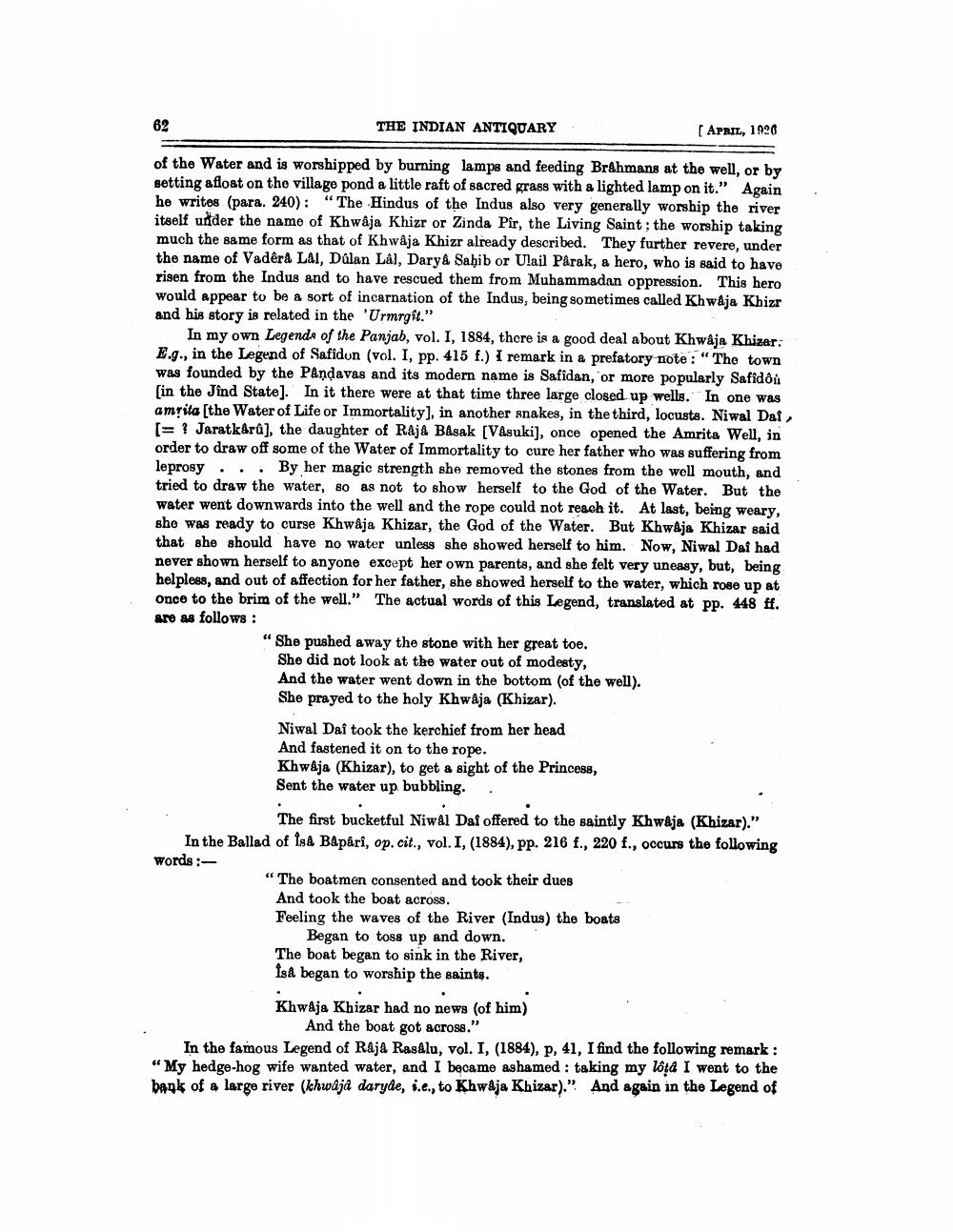________________
62
THE INDIAN ANTIQUARY
[APRIL, 1920
of the Water and is worshipped by burning lamps and feeding Brahmans at the well, or by setting afloat on the village pond a little raft of sacred grass with a lighted lamp on it." Again he writes (para. 240): "The Hindus of the Indus also very generally worship the river itself under the name of Khwaja Khizr or Zinda Pir, the Living Saint: the worship taking much the same form as that of Khwaja Khizr already described. They further revere, under the name of Vadêrå LAI, Dalan Lal, Darya Sahib or Ulail Párak, a hero, who is said to have risen from the Indus and to have rescued them from Muhammadan oppression. This hero would appear to be a sort of incarnation of the Indus, being sometimes called Khwaja Khizr and his story is related in the 'Urmrgit."
In my own Legends of the Panjab, vol. I, 1884, there is a good deal about Khwaja Khizar. E.g., in the Legend of Safidun (vol. I, pp. 415 f.) I remark in a prefatory note: "The town was founded by the Pandavas and its modern name is Safidan, or more popularly Safidoi [in the Jind State). In it there were at that time three large closed up wells. In one was amrita (the Water of Life or Immortality], in another snakes, in the third, locusts. Niwal Dai, (= ? Jaratkarů), the daughter of Raja Basak (Vasuki), once opened the Amrita Well, in order to draw off some of the Water of Immortality to cure her father who was suffering from leprosy ... By her magic strength she removed the stones from the well mouth, and tried to draw the water, so as not to show herself to the God of the Water. But the water went downwards into the well and the rope could not reach it. At last, being weary, she was ready to curse Khwaja Khizar, the God of the Water. But Khwaja Khizar said that she should have no water unless she showed herself to him. Now, Niwal Dai had never shown herself to anyone except her own parents, and she felt very uneasy, but, being helpless, and out of affection for her father, she showed herself to the water, which rose up at once to the brim of the well." The actual words of this Legend, translated at pp. 448 ff. are as follows:
She pushed away the stone with her great toe. She did not look at the water out of modesty, And the water went down in the bottom (of the well). She prayed to the holy Khwaja (Khizar). Niwal Dai took the kerchief from her head And fastened it on to the rope. Khwaja (Khizar), to get a sight of the Princess, Sent the water up bubbling. .
The first bucketful Niwal Daf offered to the saintly Khwaja (Khizar)." In the Ballad of Isa Bapäri, op. cit., vol. I, (1884), pp. 216 f., 220 f., occurs the following words :
“The boatmen consented and took their dues And took the boat across. Feeling the waves of the River (Indus) the boats
Began to toss up and down. The boat began to sink in the River, Iså began to worship the saints.
Khwaja Khizar had no news (of him)
And the boat got across." In the famous Legend of Raja Rasálu, vol. I, (1884), p, 41, I find the following remark: "My hedge-hog wife wanted water, and I became ashamed : taking my lód I went to the bank of a large river (lchwaja daryde, s.e., to Khwaja Khizar)." And again in the Legend of




